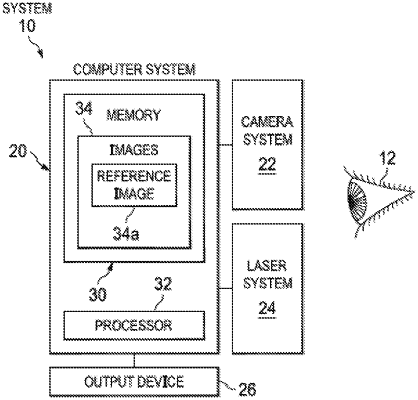| CPC A61B 3/113 (2013.01) [A61B 3/0025 (2013.01); A61F 9/008 (2013.01); A61F 2009/00846 (2013.01); A61F 2009/00897 (2013.01)] | 19 Claims |

|
1. A system for tracking movement of an eye, comprising:
a camera system configured to generate a plurality of images of the eye;
a computer system comprising:
a memory configured to store the plurality of images and store at least one of the images as a reference image; and
one or more processors configured to:
track movement of the eye within a tracking range by comparing a current image of the plurality of images with the reference image, and by determining a rotational movement of the eye from the comparison of the current image and the reference image, the tracking range having a plurality of alert points comprising a tracking boundary point and an intermediate point, the tracking boundary point representing a maximum number of degrees away from a zero point where tracking can be properly performed, the intermediate point located between the zero point and the tracking boundary point; and
determine an orientation of the eye relative to at least one alert point of the tracking range; and
an output device configured to output a range indicator that indicates the orientation of the eye relative to the at least one alert point of the tracking range, the output device comprising a speaker that outputs the range indicator as:
a first sound if the orientation of the eye corresponds to a point between the intermediate point and the tracking boundary point indicating the eye is nearing a tracking boundary beyond which tracking cannot be performed; and
a second sound different from the first sound if the orientation of the eye corresponds to a point beyond the tracking boundary point where tracking cannot be performed.
|